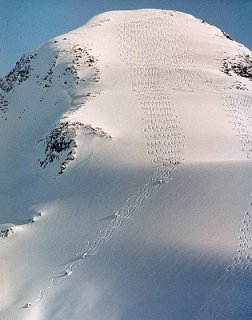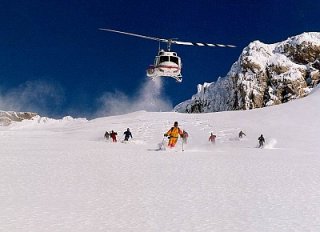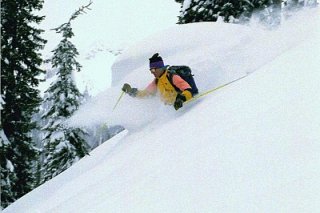Nakusp (BC), Canada – Heliskiing
is considered by many to be the ultimate way to slide downhill, and British
Columbia is widely regarded as perhaps the best way to enjoy the experience.
Canadian Mountain Holidays (CMH) is the largest and oldest heliski operation
in the world, and operates in no fewer than 11 regions within the province,
the names of many of which have become engraved into the consciousness of
many ski and snowboard enthusiasts: Adamants, Bobbie Burns, Bugaboos, Cariboos,
Galena, Gothics, Kootenay, McBride, Monashees, Revelstoke, and Valemount.
n
Kootenay Heliskiing was an independent operation
founded in 1982 and purchased by CMH in 1996. Kootenay primarily operated
with 3 and 4-day packages, far shorter than CMH’s traditional weeklong program,
so CMH has retained that structure for 18 people per week, with 27 others
on the full week plan. Kootenay is located in Nakusp, B.C., four to five
hours of driving from Spokane and severn hours from Calgary. CMH transport
is provided for the full week plan, but 3 and 4-day skiers need to rent a
car, as the location is very remote and public transport inconvenient and/or
expensive.
In February 1999 I first sampled the helicopter
skiing of the Selkirk range on a single day trip with Selkirk-Tangiers. Clouds
and snow flurries kept us out of the alpine, but there was over 3,000 vertical
of tree skiing available below timberline, and some of the powder was thigh-deep.
In March 2001 I decided to return to the Selkirks, but this time for 3 days
at CMH Kootenay.
I took the CMH Saturday bus from Calgary to Nakusp
as I had arranged for a friend to pick me up after skiing on Tuesday. It’s
an all-day trip, but CMH gets most of the paperwork out of the way en route
and prospective heliskiers usually have plenty of war stories to trade. There
was one group of 11 who showed their video from CMH Galena three years earlier.
Upon arrival most skiers immediately get measured for the complementary Atomic
Heli-Star or Volkl Explosiv fat skis provided by CMH, though I instead opted
to use my well-proven Volant Chubbs. Before dinner on the first night I noticed
the records posted of the previous week’s skiing: one no-fly day, and group
daily vertical totals ranging from 13,000 to a bit over 30,000 feet.
|
Kuskanax Lodge is what you’d expect.
While CMH Kootenay does have some high alpine terrain
En route to the pickup. (photo: Brian Anglin)
"Nearly everywhere we skied was in sheltered
|
Lodging for CMH Kootenay is at the Kuskanax and
Tenderfoot lodges. These are adjacent unassuming hotels such as you would
expect to find in a rural town like Nakusp. I received an education in Nakusp’s
remoteness from a local lady circulating a petition protesting the B.C. government’s
plan to restrict and start charging for the two nearby ferry services across
the Columbia River. The restaurant food was probably the best of the five
cat/heli operations where I have stayed overnight, although when you live
in L.A. you don’t go to interior B.C. for a gourmet experience.
“LIGHT AND DRY ALL THE WAY TO THE PICKUPS”
Breakfast is served at 7 a.m. and most skiers
arrive by 6:30 for the recommended stretching class led by the massage therapists.
On the first morning, everyone goes out to the helipad and spends about an
hour on safety instruction and practicing avalanche transceiver drills. Starting
at about 10:30 the five groups of nine skiers each head out for their first
runs in two helicopters. Many of the CMH operations use four groups per chopper,
but Kootenay’s expansive 2,000 square kilometer (772 square mile) permit area
requires more flexibility.
The Selkirk Mountains are renowned for abundant
snow and awesome tree skiing, and Sunday’s conditions fully met expectations.
The tree line is at about 7,000 feet of elevation and pickup spots ranged
between 4,000 and 5,000 feet. In March there is some risk of spring conditions
at low elevation, but the prior week had been extremely cold and Sunday’s
powder was light and dry all the way to the pickups. There was just a hint
of heavier snow on southerly exposures. Kootenay does have some alpine terrain
up to 8,500 feet, but it was cloudy up there with bad visibility so we stayed
in the trees for nine runs and 17,000 vertical.
The terrain features many changes in pitch, and
we dropped some nice steep shots as the guides had assessed excellent snow
stability. Kootenay is properly recommended by CMH for experienced powder
skiers, as your attention is best focused on choosing a nice line through
the forest and not worrying about the basics of powder survival. We had a
first-timer in our group, and he did not hold us up much despite several crashes.
He unfortunately awoke on the second day with a back so sore that he was unable
to ski the other two days. He would likely have been just fine for glacier
skiing, where you can more easily develop a rhythm of consistent powder turns.
At the end of the ski day at Kootenay the helicopters
land close to Nakusp Hot Springs. Most skiers unwind in the large 100 ºF
pool or the smaller one that is 108 degrees before returning to the hotels.
On Sunday night we were warned of a substantial storm expected for Monday.
Given the quality of the week-old snow that we had just skied, I could envision
epic powder over the next two days. As for the weather, I thought the forested
terrain would enhance our chances of getting out.
“WE MIGHT TRY CURLING”
After the first day, CMH vans depart for the helipad
at 8:15 a.m., giving addicted powderhounds the opportunity for more runs.
On Monday morning there was light drizzle in Nakusp, which is next to Arrow
Lake and the Columbia River at only 1,500 feet of elevation. Each helicopter
took off with one group, but returned after only one run and shut down for
the day. When the helicopters rose to higher altitude the water on the blades
started to freeze, altering their shape and thus their lift characteristics.
This was Kootenay’s 12th down day of the season, slightly more
than normal. Other nearby CMH operations in Galena and the Bugaboos were
also not flying on Monday. Reasons for not flying are about equally divided
among wind, visibility and the freeze problem that we had encountered.
The guides thought that we might try curling at
the local ice rink to keep us entertained on Monday, but it was unfortunately
not available that day. I wandered over to the local library’s Internet terminal,
noted Whistler’s 42 cm. new snow that day, and realized that my final day
of heliskiing might also be at risk.
On Monday night we were treated a slide show by
Tim Rippel, one of the CMH Kootenay guides who has taken part in no fewer
than six Mt. Everest expeditions. The slides were mostly from 1997, when
he came within 80 vertical meters of the summit from the north side. In 2000
Tim attempted to be the 5th climber ever to solo Everest, but he
ran out of time due to weather delays.
“NEARLY EVERYWHERE WE SKIED WAS IN SHELTERED
TREES”
On Tuesday it was not raining in Nakusp, but it
was still cloudy and snowing in the mountains. After our first run we waited
in the snow for about 45 minutes while the guides and pilots conferred on
locations for adequate flying visibility. They fortunately found such an
area, and we pretty much stuck to it all day, with six of our ten runs that
day ending at the same pickup point at 5,100 feet. Monday’s storm was fairly
warm and the snow level had risen to 4,500 feet. We had a couple of runs
that ended just below that level, where we all appreciated the value of fat
skis.
About 20 inches of new snow blanketed the ground
on Tuesday, but it was fairly dense such that you didn’t sink in very far.
There was little crust or wind-blown snow as nearly everywhere we skied was
in sheltered trees, and there the dense surface skied very smoothly. Tuesday’s
snow surface felt very familiar, as it was rather similar to some of my better
Sierra powder days.
At lunch our guide dug a pit to demonstrate snow
stability. There were two big layers of dense snow over a foot deep, with
about an inch of very light powder between them. This middle layer was barely
visible, but if you pushed on the top layer it would slide off the bottom
layer. The guide said that the two dense layers would compress and merge
together in a couple of days.
Since the scope of Tuesday’s
skiing was constrained by weather, I wound up with 18,200 vertical for the
day and 35,200 for the trip. As the guarantee is 43,000 vertical fee, I received
a refund of CDN $180 from the trip’s USD $1,800 purchase price. I can tell
you from experience that it’s much better to be paying extra at the end of
a heliski trip, but poor weather is a risk that we take on any time that we
ski. With good weather, skiers should budget about USD $350 for extra vertical.
And as lead guide Ken France pointed out, the quality of skiing on a weather-restricted
day is much better at Kootenay than at most heli operations. Since 1997 I
have tried several Canadian snowcat and heli operations over one- to three-day
periods. After 4 days of trying in this mountain range, though, I’m still
looking for that ultimate Selkirk run of 2,000 vertical in the alpine flowing
into another 2,000 of steep and deep in the trees.





